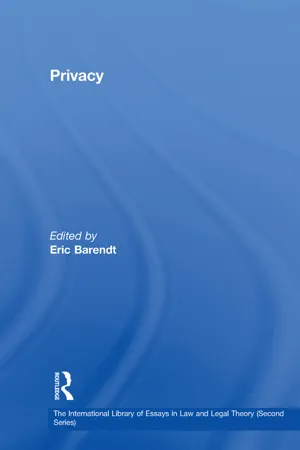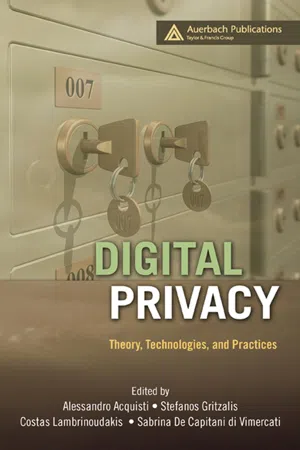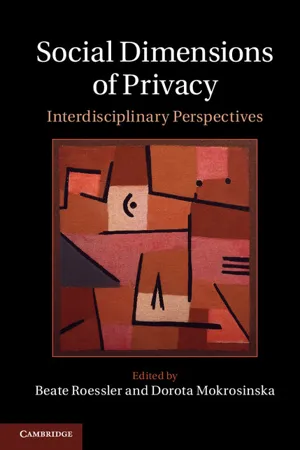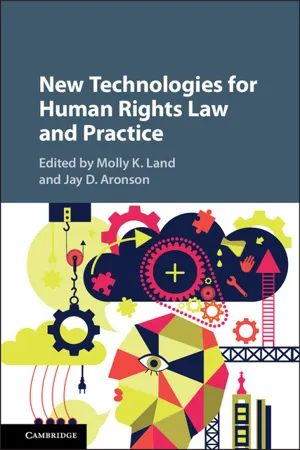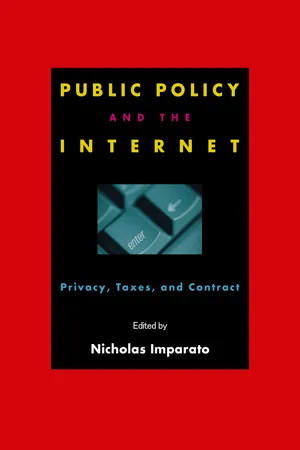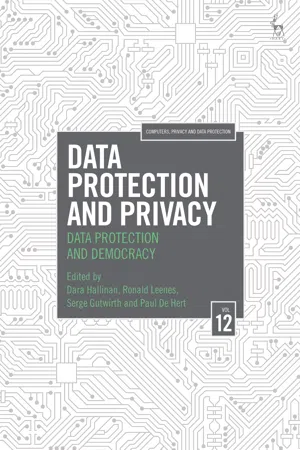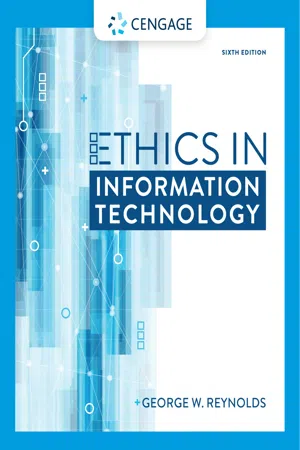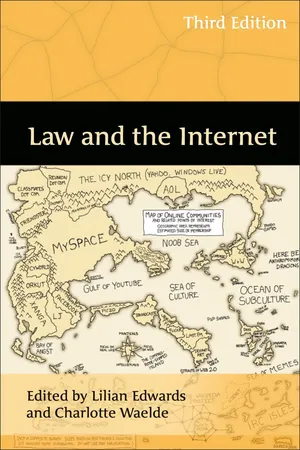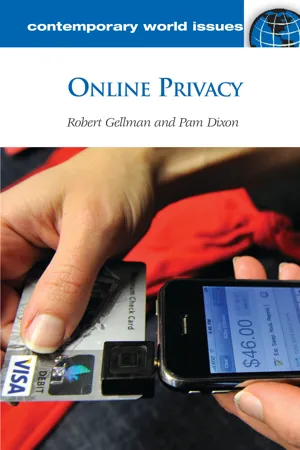Law
Privacy and electronic communications regulations
Privacy and electronic communications regulations refer to laws that govern the protection of personal data and privacy in electronic communications. These regulations typically cover issues such as consent for electronic marketing, confidentiality of communications, and the use of cookies and similar tracking technologies. They aim to safeguard individuals' privacy rights in the digital environment and ensure that their personal data is handled responsibly.
Written by Perlego with AI-assistance
Related key terms
1 of 5
11 Key excerpts on "Privacy and electronic communications regulations"
- eBook - ePub
- Eric Barendt(Author)
- 2017(Publication Date)
- Taylor & Francis(Publisher)
Part IV applies the privacy model to the world of cyberspace. Specifically, this article argues that cyberspace should be regarded not merely as a technological innovation facilitating communication but also as a cultural sphere characterized by distinct forms of social organization and rules of interaction. The unique social and geopolitical structure of the electronic communications environment weighs against reliance on traditional assumptions about the nature of privacy and requires us to take a fresh approach to privacy rights which will limit others’ ability to engage in surveillance and information gathering.Part IV hence examines the reasons for extending privacy rights to cyberspace communications and discusses probable consequences of privacy deprivation. Those consequences are made comprehensible by the theoretical privacy model developed in prior sections, which regards privacy as a means both of maintaining individual personhood and of constructing interpersonal relationships. The author contends that the unregulated collection of commercial data engenders alienation because it deprives the individual of control over access to his personal information. Non-regulation also allows those who collect and deal in information to accumulate social power at the expense of the individual, a process which ultimately could inhibit the development of political democracy in cyberspace.Finally, Part V proffers some suggestions for cyberspace privacy regulation. As various authors have noted, existing regulations aimed at addressing privacy concerns in the context of electronic communications are inadequate. This article also critically examines the idea that a regulatory framework should be permitted to develop gradually, either by relying on the self-governance of network communities or by allowing privacy safeguards to emerge through contractual means. Neither alternative recognizes the power disparities between individual network users and information brokers. Moreover, neither alternative presents an effective means of creating a uniform and coherent approach to cyberspace privacy rights. Instead, this article argues for the establishment of a federal regulatory mechanism as a vehicle for developing a coherent privacy framework that is adapted to the specific contingencies of an electronic communications environment. - eBook - PDF
Emerging Challenges in Privacy Law
Comparative Perspectives
- Normann Witzleb, David Lindsay, Moira Paterson, Sharon Rodrick(Authors)
- 2014(Publication Date)
- Cambridge University Press(Publisher)
PART V Privacy and the Internet 259 12 Data privacy law and the Internet: policy challenges Lee A. Bygrave A repeat of the catch-up catechism? Data privacy law is a relatively young field of regulation. 1 It is also a child of modern information and communication technology (ICT). 2 Remarkably, though, the bulk of codes making up its core were drafted before the wide- spread adoption of one of the most important manifestations of modern ICT: the Internet. Data transmission networks based on the Transmission Control Protocol and Internet Protocol (TCP/IP) 3 became established as a ubiquitous backbone for electronic transactions by the late 1990s. At that time, the basic tenets of data privacy law were already long in place. While some of the most recent legislation in the field takes specific account of the Internet and its virtual worlds, 4 most of the field’s seminal codes do Research for this chapter has been supported by EINS, the Network of Excellence in Internet Science (www.internet-science.eu), which is funded through the European Commission’s 7th Framework Programme under Communications Networks, Content and Technologies (Grant Agreement no. 288021). References to legal instruments are to their amended state as of 1 October 2013, and all websites were last accessed on that same date. 1 At the risk of spelling out the obvious, ‘data privacy law’ herein denotes a set of legal norms that specifically govern the processing of personal data (i.e. data relating to and enabling identification of individual, physical/natural persons (and sometimes corporations and other legal persons)) in order to protect, at least partly, the privacy-related interests of the data subjects (i.e. the persons to whom the data relate). In Europe, such norms tend to be described as ‘data protection’. In Australia, Canada and the USA, they tend to be described in terms of protecting ‘privacy’, ‘information privacy’ or, increasingly, ‘data privacy’. - eBook - PDF
Digital Privacy
Theory, Technologies, and Practices
- Alessandro Acquisti, Stefanos Gritzalis, Costos Lambrinoudakis, Sabrina di Vimercati, Alessandro Acquisti, Stefanos Gritzalis, Costos Lambrinoudakis, Sabrina di Vimercati(Authors)
- 2007(Publication Date)
- Auerbach Publications(Publisher)
Communications Data Retention 419 communications [5]. The fact that the data is retained by private parties (providers) is not decisive. Significant for the classification as interference, it remains that the authorities have the right, as specified by domestic law, to access the data at any time [8,28]. 20.4 Privacy and Electronic Communications Law in the United States 20.4.1 The Legal Framework: The Electronic Communications Privacy Act Electronic surveillance in the United States emerged as early as the use of telegraph during the Civil War, with Congress attempting to obtain tele-graph messages maintained by Western Union; an attempt that raised “quite an outcry” [43]. The current framework of communications surveillance is dominated by the “strong sense of vulnerability” to the terrorist threat. The latter reinforced the orientation of the government to strengthen the hand of law enforcement agencies, enabling them to trace electronic communi-cations. The USA PATRIOT Act emerged as a response to the September 11 attacks, but undoubtedly the significant problems concerning communica-tions surveillance and intelligence gathering predate the recently adopted framework. Electronic surveillance law is comprised of the statutory regimes in-troduced by the Electronic Communications Privacy Act (ECPA) of 1986. Congress amended Title III of the Omnibus Crime Control and Safe Streets Act of 1968 in order to extend the prohibitions on interception to electronic communications and to craft new guarantees for stored communications and records. ECPA covers wire, oral, and electronic communications and is structured into three titles: (1) the Wiretap Act, (2) the Stored Communica-tions Act, and (3) the Pen Register Act. The Wiretap Act deals with the interception of communications while in transmission, “even if they are briefly stored” (U.S. Courts of Appeals, U.S. v. Councilman ). - eBook - PDF
Social Dimensions of Privacy
Interdisciplinary Perspectives
- Beate Roessler, Dorota Mokrosinska(Authors)
- 2015(Publication Date)
- Cambridge University Press(Publisher)
A wave of books discussed “the end of privacy” (Sykes 1999) resulting from a “database nation” (Garfinkel 2000) that held and kept everything on record and in which there was consequentially “no place to hide” (O’Harrow 2006). When encryption of electronic commu- nication was promoted by civil rights activists and computer scientists as a means to keep electronic communication private, a conflict ensued with state interests to outlaw such technology and keep email and other com- munication accessible for (inter alia) the purposes of law enforcement (Diffie and Landau 1998). Privacy, technology, and regulation 307 The massive spread of mobile phones (with some Internet access) and smartphones (which are actually small computers in disguise) from the early 2000s onwards led to a new situation of “computing anywhere” (or ubiquitous computing) and both multiplied and globalized the num- ber of users. At the same time, an explosion of e-commerce meant that as ever more goods and services were booked and bought online, ever more people left constant traces of their activities as well as their phys- ical whereabouts in electronic form for their service providers to store and use. Services such as search, email, photo storage, and so on were offered for free, but effectively in exchange for obtaining users’ personal data. Debates about the privacy consequences of these developments became both more sophisticated and moved from being conducted pri- marily between experts into the policy mainstream, where they covered both private and public sector behavior. Large-scale hearings in parlia- ments as well as the establishment of special committees resulted from it in several countries (e.g. Deutscher Bundestag 2013; House of Lords. Select Committee on the Constitution 2009). - Molly K. Land, Jay D. Aronson(Authors)
- 2018(Publication Date)
- Cambridge University Press(Publisher)
Although governments have had the capacity to access and store unprecedented quantities of digital communications data for some time, high-profile terrorist attacks and expanding transnational crim- inal activity have provided a strong motive to continue and expand these activities. When Edward Snowden revealed the global scope of existing communications surveillance capacity, states and civil society organizations turned to international law to seek clarity on how the right to privacy protects individuals, preserves legitimate state interests, and addresses the realities of the large-scale collection of data across traditional borders. The tribunals and experts who interpret international human rights law have developed a rich body of standards on the right to privacy in communications, with European institutions leading the way. These standards address much of the present-day collection and use of digital communications, but significant gaps still exist. Until recently, there were few clear norms regarding the bulk collection of communications data, the responsibility of private companies to respect privacy rights, and the rules and protections that apply when communications data crosses borders. This chapter explores the evolution of the right to privacy as it is established in international human rights law, and the ways in which human rights law is begin- ning to bridge these gaps. The first part provides an overview of the right to privacy and highlights developments in the digital age that international human rights law 1 All opinions expressed in this chapter are those of the author alone and should not be attributed to any organization. Lisl would like to thank Sarah St. Vincent for her thoughtful comments on prior versions of this chapter. 217- eBook - ePub
Public Policy and the Internet
Privacy, Taxes, and Contract
- Nicholas Imparato(Author)
- 2013(Publication Date)
- Hoover Institution Press(Publisher)
Mary J. Cronin1
Privacy and Electronic Commerce
E very opinion and lifestyle variant known to humankind has found a home somewhere on the Internet, so it should come as no surprise that the global network has also spawned diverse and deeply held positions on the subject of on-line privacy. It might seem that the very nature of the net, with its open participation and millions of entry points around the globe, runs counter to many traditional notions about privacy. But labeling “Internet privacy” an oxymoron is not likely to end the debate. The explosion of web sites actively collecting, mining, and sharing information about individual Internet users has prompted a serious policy division between those countries (notably the United States) that support self-regulation of Internet privacy practices and those that have enacted government measures to protect personal data. Privacy has also emerged as a touchstone for consumer concerns about the Internet, fueled by media revelations of behind-the-scenes web data collection practices.This chapter discusses the major issues that have emerged in the debate over on-line privacy, with a particular focus on the differences between the regulatory outlook in the United States and that in the European Union. It raises three related policy questions:- Is the appropriate balance between privacy and information disclosure best negotiated between the individual users and the web sites they choose to visit or is some type of regulation or external review required to improve current privacy practices?
- Does the U.S. reliance on corporate self-regulation put it on a collision course with the European Union and other regions that have opted for government-enforced privacy protection standards?
- eBook - PDF
Data Protection and Privacy, Volume 12
Data Protection and Democracy
- Dara Hallinan, Ronald Leenes, Serge Gutwirth, Paul De Hert, Dara Hallinan, Ronald Leenes, Serge Gutwirth, Paul De Hert(Authors)
- 2020(Publication Date)
- Hart Publishing(Publisher)
39 In response to the above, the ePrivacy Regulation as originally drafted by the Commission aims to protect both the content of communications and the related metadata. In this context, the Commission’s draft drops the concept of traf-fic data and location data and uses ‘metadata’ instead. Under the Commission’s draft ePrivacy Regulation, the concept of metadata contraposes that of content. 40 In particular, the ePrivacy Regulation contains a more specific definition of ‘elec-tronic communications metadata’ as: ‘data processed in an electronic communications network for the purposes of trans-mitting, distributing or exchanging electronic communications content; including data used to trace and identify the source and destination of a communication, data on the location of the terminal equipment processed in the context of providing electronic communications services, and the date, time, duration and the type of communication’. 41 This new definition covers what the ePD defines as traffic data and location data. The reason for this merge lies in the increasing generation of data and the computing capacity to store and analyse it. As a result of these technological advancements, even when some electronic communications data were deleted, The Proposed ePrivacy Regulation 279 42 Article 29 Data Protection Working Party, Opinion 03/2016 (n 39) p 14. 43 Art 4.3(b) ePrivacy Regulation, as drafted by the Parliament Proposal. 44 S Stalla-Bourdillon, E Papadaki and T Chown, ‘Metadata, Traffic Data, Communications Data, Service Use Information … What is the Difference? Does the Difference Matter? An Interdisciplinary View From the UK’ in S Gutwirth and R Leenes, Data Protection on the Move (Springer 2015). Available at: https://papers.ssrn.com/sol3/papers.cfm?abstract_id=2625181. 45 See also recital 14(a) as drafted by the Parliament Proposal. - eBook - PDF
- George Reynolds(Author)
- 2018(Publication Date)
- Cengage Learning EMEA(Publisher)
Due to electronic rights, some third party content may be suppressed from the eBook and/or eChapter(s). Editorial review has deemed that any suppressed content does not materially affect the overall learning experience. Cengage Learning reserves the right to remove additional content at any time if subsequent rights restrictions require it. Electronic Communications Privacy Act (1986) The Electronic Communications Privacy Act (ECPA) (18 U.S.C. § 2510-22) deals with three main issues: (1) the protection of communications while in transfer from sender to receiver; (2) the protection of communications held in electronic storage; and (3) the prohibition of devices from recording dialing, routing, addressing, and signaling informa-tion without a search warrant. ECPA was passed as an amendment to Title III of the Omnibus Crime Control and Safe Streets Act. Title I of ECPA extends the protections offered under the Wiretap Act to electronic communications, such as email, fax, and text messages sent over the Internet. The gov-ernment is prohibited from intercepting such messages unless it obtains a court order based on probable cause (the same restriction that is in the Wiretap Act relating to tele-phone calls). Title II of ECPA (also called the Stored Communications Act) prohibits unautho-rized access to stored wire and electronic communications, such as the contents of email inboxes, text messages, message boards, and social networking sites. However, the law only applies if the stored communications are not readily accessible to the general public. Webmasters who desire protection for their subscribers under this act must take careful measures to limit public access through the use of logon procedures, passwords, and other methods. Under this act, the FBI director or someone acting on his behalf may issue a National Security Letter (NSL) to an Internet service provider to provide various data and records about a service subscriber. - eBook - ePub
- Lilian Edwards, Charlotte Waelde, Lilian Edwards, Charlotte Waelde(Authors)
- 2009(Publication Date)
- Hart Publishing(Publisher)
Like telephone metering data in previous decades, it is also covered by the definition of ‘private life’ 13 contained in Article 8 of the European Convention on Human Rights (ECHR). To fully understand the extent to which the use of communications data can affect an individual’s right under Article 8 ECHR, a distinction must be made between the conditions under which such data can or must be retained and the grounds on which it can be accessed. III. RETENTION OF COMMUNICATIONS DATA A. Voluntary Retention of Communications Data At the European level, the DPD requires Member States to ensure that data controllers only collect personal data for specified, explicit and legitimate purposes and do not further process this in a way incompatible with those purposes. 14 Under Article 6(1)(d), data controllers must also take every reasonable step to ensure that data which is inaccurate or incomplete is erased or rectified. In addition, the Privacy in Electronic Communications Directive (PECD) 15 requires Member States to ensure the confidentiality of communications and related traffic data in public telecommunications networks and publicly available electronic communication services. 16 It also stipulates that CSPs must erase or make anonymous any traffic or billing data they generated upon termination of the communication in question, unless they require such data for their own billing or marketing purposes (the latter use being subject to the subscriber’s consent). 17 CSPs which continue to retain communications data beyond the requisite period are likely to face civil and criminal liability - eBook - PDF
Online Privacy
A Reference Handbook
- Robert Gellman, Pam Dixon(Authors)
- 2011(Publication Date)
- ABC-CLIO(Publisher)
On the other hand, conversations in the open would not be protected against being overheard, for the expectation of privacy under the circum- stances would be unreasonable. Electronic Communications Privacy Act Title I amends the Wiretap Act, a criminal statute that seeks (1) to protect the privacy of wire and oral communications and (2) to set out the circumstances and conditions under which the interception of wire and oral communications may be authorized. Title II of the Electronic Communications Privacy Act is the Stored Communications Act, which protects email and similar electronic communications and protects data transfers between businesses and customers. Major sections of Title II are set out here. 162 Data and Documents 18 U.S.C. § 2701. Unlawful access to stored communications (a) Offense.—Except as provided in subsection (c) of this section whoever— (1) intentionally accesses without authorization a facility through which an electronic communication service is provided; or (2) intentionally exceeds an authorization to access that facility; and thereby obtains, alters, or prevents authorized access to a wire or electronic communication while it is in electronic storage in such system shall be punished as provided in subsection (b) of this section. - eBook - PDF
- Douglas Maule, Zhongdong Niu(Authors)
- 2014(Publication Date)
- EUP(Publisher)
PRIVACY 119 7 PRIVACY DEFINING PRIVACY The right to privacy is a fundamental human right internationally recognised, most prominently in the Universal Declaration of Human Rights, the International Covenant on Civil and Political Rights and the European Convention on Human Rights. Although the UK is a founding signatory to the ECHR, the right to privacy was only incorporated into UK law in 1998 when the Human Rights Act was passed by Parliament. However, the privacy right is often found in conflict with other interests and intrusion into one’s privacy is allowed under the ECHR where it is necessary for the detection of crime or corruption or when national security is at stake, and, most contestedly, freedom of the media. Even in such instances, though, it is crucial that any invasion of a person’s privacy is in direct proportion to any potential harm that would occur should the information be kept private. In other words, it should relate only to the private material necessary for the public interest. In cases where there is no public interest in disclosure, it is clear that the right to privacy is a vitally important, if not necessary, condition for human dignity and fulfilment and that it should be strictly upheld. There is little argument that everyone should be entitled to keep their private life private as far as necessary to enable them to cultivate relationships with others, particularly intimate ones, and to maintain their physical and psychological well-being. However, it is extremely difficult to come to a clear conclusion on what the term means in a practical sense. Therefore privacy can reasonably be said to be difficult to define satisfactorily. In fact, the problems associated with constructing a straightforward and understandable definition of “privacy” have been present since the notion of a right to privacy itself. By far the most prominent reason for this is the vast difference in human perceptions of their private life and affairs.
Index pages curate the most relevant extracts from our library of academic textbooks. They’ve been created using an in-house natural language model (NLM), each adding context and meaning to key research topics.
